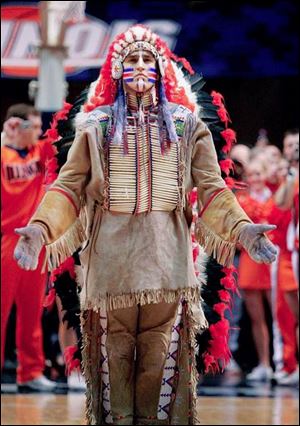
It was time for Chief Illiniwek to go
2/26/2007
University of Illinois mascot Chief Illiniwek performs for the last time on Wednesday. The NCAA considered the mascot offensive to Native Americans and barred the school from hosting postseason athletic events until he was removed.
Jamie Oxendine is president of the Black Swamp InterTribal Foundation based in Perrysburg. It is a state and federal nonprofit 501(c)(3) Native American organization. He is also a Native American speaker with both Bowling Green State University and the Toledo Public Schools. He is a guest professor in Native American culture at BGSU. He is of Lumbee/Creek ancestry and a member of the Lumbee tribe of North Carolina.
It is amazing to see how many people feel that Chief Illiniwek of the University of Illinois is not offensive to Native Americans. It is even more amazing to hear how many people think that Chief Illiniwek is something of respect and honor for Native Americans.
Then I realize that everybody that says such things is not Native American, and most know nothing about the Native American culture.
In less than one week, I have read more than 400 articles, threads, posts, chats, e-mails, and private messages (many not very kind) about the end of Chief Illiniwek.
Most people say the following: The idea that the Chief insults Native Americans is absurd because the performances are stirring, dignified, respectful. It is not presented as some cartoon caricature or savage but as a proud symbol of strength and courage.
What a naive thing to say.
Nothing the Illinois mascot did was Native American. The dance is not our dance. The gestures are not our gestures.
We don t dance in jumps and leaps and splits in the air.
We don t hold our arms out and cross them in front of us and stand with a blank stoic look.
We don t dance to a marching band playing so-called Indian music that is really European classical music that Hollywood borrowed from composers like Dvorak and Liszt.
We don t dance in our bare feet.
The only thing about the mascot that was Native American was some of the clothing. But it was not Illini, it was Lakota Sioux.
The Illini were woodland people of the lower Great Lakes, the Lakota Sioux are of the northern plains two completely different cultural areas.
Everytime the Native American mascot issue comes up people always argue about Florida State having a Native American Mascot.
So what gives?
Well, if they did some research they would discover that the Florida State mascot (Osceola) is approved by the Seminole tribe of Florida and that the Seminole tribe made sure that the mascot represents the Seminole in correct clothing of the 19th century.
The Seminole tribe also makes sure that the person who portrays Osceola does not do any ignorant gestures or senseless dancing.
Could the University of Illinois have done the same thing?
Yes, according to the compromise proposal of 2000, several Native American groups suggested that the mascot be dressed in appropriate clothing of the Illini, be Native American, and not do any ridiculous dancing or gestures.
Here in Ohio we have a similar issue with the logo of the Cleveland Indians.
And again, everybody argues that the name and logo were chosen to honor a Native American that played for the Cleveland Spiders in 1897.
I wrote a five-page thesis on the subject several years ago and found that some of that was true and some of that was not true. But that is another article to be discussed later.
There are many Native Americans that are Cleveland Indians fans. They love the team and the name but hate the Chief Wahoo logo.
Some Native Americans say the name is honorable but the logo is not.
Some hate both the name and logo, and you can find some that don t care because they are not Cleveland Indians fans.
Many Native Americans simply say keep the name Cleveland Indians and change the logo.
After all, since 1990 the Cleveland Indians mascot is a fuzzy character called Slider and not Native American and the logo is really a redrawing of a 1940 cartoon caricature used in Nazi Germany.
So the mascot issue goes both ways even with Native Americans.
But my research indicates that many Natives would not have a problem with the mascots or logos if they were done correctly and appropriately meaning the mascot, the name, and the logo must be done to represent and honor past and presentNative Americans.